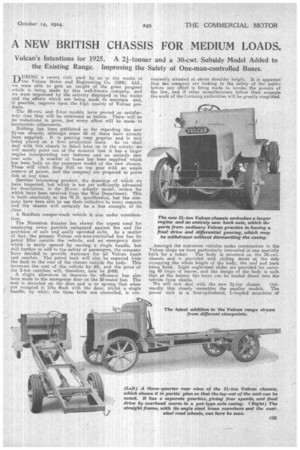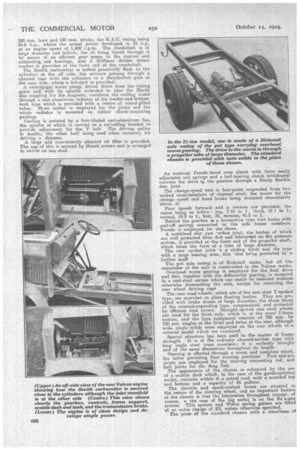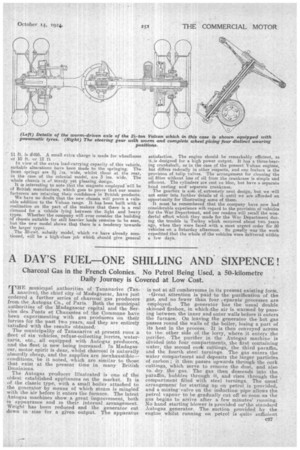A NEW BRITISH CHASSIS FOR MEDIUM LOADS.
Page 9

Page 10

Page 11

If you've noticed an error in this article please click here to report it so we can fix it.
Vulcan's Intentions for 1925. A 21-tonner and a 30-cwt. Subsidy Model Added to the Existing Range. Improving the Safety of One-man-controlled Buses.
11 URING a iecent visit paid by us to the works of the Vulcan Motor and Engineering Co. (1906) Ltd., we were able to gain an insight of the great progress which is being made by this well-known company. and we were impressed by the activity displayed in the works and the efforts which are being made t6 maintain and, if possible, improve upon the high quality of Vulcan products.
The 30-cut. and 2-ton models have proved so satisfactory that they will be continued as before. There will be no reductions in price, but every effort will be made to incorporate refinements.
Nothing has been pnblished so far regarding the new 21-ton chassis, although some 50 of these have already been supplied. It is proving very popular and is now being placed on a firm production basis. As we -shall deal with this chassis in detail later on in the article, we will merely point out at the moment that it has a larger engine incorporating new features and an entirely new rear axle. A number of buses has been supplied which has been built on the passenger model of the new chassis. These will climb Shap Fell on top gear with an ample reserve of power, and the company are prepared to prove this at any time. Another interesting product, the drawings of which we have inspected, but which is not yet sufficiently advanced for description, is the 30-cwt. subsidy model, orders for which have been received from the War Department. This is built absolutely to the W.D. specification, but the company have been able to use their initiative in many respects and the chassis will certainly be a fine example of its class.
A Roadless creeper-track vehicle is also under consideration.
The Nuneaton disaster has shown the urgent need for employing every possible safeguard against fire and the provision of safe and easily operated exits. As a matter of fact, -the present Vulcan one-man-controlled bus has its petrol filler outside the vehicle, and an emergency door which is easily opened by moving a single handle, but still further to add to the safety of passengers, the company have decided to provide Antovacs for all Vulcan buses and coaches. The petrol tank will also be removed from the dash to the rear of the chassis outside the body. This increases the cost of the vehicle by £5, and the price of the 2-ton omnibus will, therefore, now be £480. A slight alteration to improve its efficiency has also been made to the emergency door on the 20 seaterbus. The seat, is mounted on the door aud is so sprung that when not occupied it lifts flush with the door, whilst a single handle, by whicli the three bolts are controlled, is con veniently situated at about shoulder height. It is apparent that the company are looking to the safety of the public before any effort is being made to invoke the powers of the. law, and if other manufacturers follow their example the work of the Icensing authorities will be greatly simplified.
Amongst the numerous vehicles under construction in the Vulcan shops we were particularly interested in one specially built for a baker. The body is mounted on the 30-cwt. chassis and is provided with sliding doors at the side occupying the whole length of the body, the roof and back being fixed. Light angle-steel slides are provided for carrying 60 trays of loaves and the design of the body is such that at the bakery the trays can be loaded direct into the vehicle from chutes.
We will now deal with the new 2-ton chassis. Outwardly this closely resembles the smaller models. The power unit is a fonr-cylindered, L-headed monobloc of 100 mm. bore and 130 rem. stroke, the R.A.C. rating being 24.8 whilst the actual power developed is 35 h.p. at an engine speed a 1,400 r.p.rn. The crankshaft is of large diameter and hollow, the oil being forced through it by means of an efficient gear pump to the journal and connecting rod bearings, and a Hoffman double thrust washer is provided at the front end of the crankshaft.
The Zenith carburetter is bolted practically flush to the cylinders at, the off side, the mixture passing through a channel cast with the cylinders to a distribution pipe at the near side, where a hot-spot is provided.
A centrigugal water pump, driven direct from the timing gears and with its spindle extended to take the Hardy disc coupling for the magneto, circulates the cooling water through a cast aluminium radiator of the header-and-bottomtank type which is provided with a centre of round gilled tribes. Shaet rubber is employed for the joints and the -whole radiator is mounted on rubber shock-insulating packing.
Cooling is assisted by a four-bladed cast-aluminium fan, the spindle of which is carried on a swivelling bracket to provide adjustment for the V belt. The driving pulley is doubla, the other half being used when necessary for driving a dynamo. A large and conveniently situated oil filler is provided. The cap of this is secured by thumb screws and !s, arranged to swivel on one stud. An external Ferodo-faced cone clutch with three easily adjustable coil springs and a ball-bearing clutch withdrawal conveys the drive tv the gearbox through a Hardy flexible disc joint.
The change-speed unit is four-point suspended from two arched cross-members of channel steel, the levers for the change speed and hand brake being mounted immediately above it.
Four speeds forward and a reverse are provided, the ratios being as follow: top, 7.75 to 1, third, 12 1 to 1; secand, Mg to 1; first, 31, reverse, 41.5 to 1. Behind the gearbox is; a locomotive type foot brake with pull-off springs connected to the side • frame members, Ferodo is employed for the shoes. A. combined star ,ype -ardan joint, the bushes of which are well protected from dirt and lubricated on the pressure system, is provided at the front end of the 'propeller shaft, which takes the form of a tube of large diameter. The rear cardan joint 's a sliding block and die type with a large bearing area, this 'oint betng protected by a leather muff: The pat aide casing is of Kirkstall make,__ but all the remainder of the axle is constructed in the Vulcan works.
Overhead worm gearing is employed for the final drive and this, together with the differential gearing, is mounted in a cest-steel carrier which can easily be removed without otherwise dismantling the axle, except for removing the rear wheel driving caps
The, rear road wheels, which are of the cast steel 17-spoked tzpe, are mounted on plain floating bushes. They are provided with brake drums of large diameter, the shoes being of the internal-expanding type, compensated, and protected by efficient dust covers. Straight spoked cast steel wheels are used for the frcnt axle, which is of the usual I-beam • section, and the -tyre equipment consists of 720 mm. by 100 mm. singles at the front and twins at the rear, although wide singlesolids were employed on the rear wheels of ,a colonial model which we examined.
Special attention has been paid to the matter of frame strength. It is of the ordinary channel-section type with long angle steel truss members ; it is perfectly straight and of the same dimensions throughout its length.
Steering is effected through a worm and complete wheel, the latter providing four wearing positions. Fork and-pin joints are employed for the steering connecting rod, and ball joints for the drag link.
The appearance of the chassis is enhanced by the use of a scuttle dash which, in the case of the goods-carrying model, contains within it a petrol tank with a rounded top and bottom and a capacity of 14 gallons.
The throttle and spark-control levers are situated in the centre of the steering wheel, and an important feature of the chassis is that the lubrication throughout (except, of course, n the case of the big units 1 is on the Ex a-gun system. This system and Wefco spring gaiters are fitted at an extra charge of £5, unless otherwise specified.
The prim of the standard chassis with a wheelbase of
11 ft. is £495. A small extra charge is made for wheelbases or 10 ft. or 12 ft
In view of the extra load-carrying capacity of this vehicle, suitable alterations bare been made to the springing. The front springs are 2 ins. wide, whilst those at the rear, in the case of the colonial model, are 3 ins. wide. The whole chassis is oF sturdy yet pleasing design. It is interesting to note that the magneto employed-will be of British manufacture, which goes to prove that our manufacturers are retaining their confidence in British products.
We have no doubt that the new chassis will prove a valuable addition to the Vulcan range. It has been built with a realization on the part of the makers that there is a real remand for a vehicle lying between the light and heavy types. Whether the company will ever consider the building of chassis suitable for still heavier loads remains to be seen, but the new model shows that there is a tendency towards the larger types.
The 30-cwt. subsidy model, which we have already mentioned, will be a high-class job which should give general
satisfaction. The engine should be remarkably efficient, as it is designed for a high power output. It has a three-bearing crankshaft, as in the case of the present Vulcan engines, but differs radically in other respects, and one feature is the provision of tulip valves.The arrangement for cleaning the oil filter without loss of oil from, the crankcase is simple and efficient. The cylinders are cast en bloc, hut have a separate head casting and separate crankcase.
• The gearbdx is alsb of, extremely neat design, but we will not enter into further details of it until we are afforded an opportunity for illustrating some of them. . It must be remembered that the company have now had considerable experience wih regard to the provision of vehicles for the War Department, and our readers will recall the wonderful effort which they made for the War. Department during the trouble in Turkey which occurred about two years ago, when they were faced with a most urgent order for 60 vehicles on a Saturday afternoon. So greatly was the work expedited that the whole of the vehicles were delivered within a few days.






























